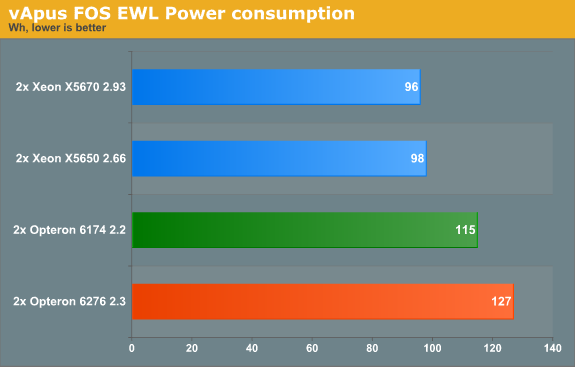Bulldozer for Servers: Testing AMD's "Interlagos" Opteron 6200 Series
by Johan De Gelas on November 15, 2011 5:09 PM ESTMeasuring Real-World Power Consumption, Part One
The Equal Workload (EWL) version of vApus FOS is very similar to our previous vApus Mark II "Real-world Power" test. To create a real-world “equal workload” scenario, we throttle the number of users in each VM to a point where you typically get somewhere between 20% and 80% CPU load on a modern dual CPU server. The amount of requests is the same for each system, hence "equal workload".
The CPU Load on the Opteron 6276 looked like this:
The CPU load is typically around 30-50%, with peaks up to 65%. At the end of the test, we get to a low 10%, which is ideal for the machine to boost to higher CPU clocks (Turbo) and race to idle. First we check out the response times.
| vApus FOS Response times (ms) | ||||||||
| CPU | PhpBB1 | PHPBB2 | MySQL OLAP | Zimbra | ||||
| AMD Opteron 6276 | 134 | 47 | 3.6 | 44 | ||||
| AMD Opteron 6174 | 118 | 41 | 3.8 | 45 | ||||
| Intel Xeon X5670 | 76 | 27 | 2.2 | 28 | ||||
ESXi and our Interlagos "Opteron" probably don't understand each other fully, given the newness of the architecture. Some extensive monitoring with ESXtop shows that the lower CPU load is spread among all the cores, and the result is that the Opteron 6276 never reaches its highest clock speed (3.2GHz). That helps make the response times significantly higher than on the Xeon, although they are acceptable. Again, the Interlagos Opteron fails to really beat the "Magny-cours" Opteron.
Our main focus of this benchmark is of course energy consumption.

The Xeon consumes 25% less power, and the older Opteron about 10% less. The performance/Watt ratio of the newest Opteron looks rather bad when running on top of ESX. We shall delve into this deeper in the next several pages.











106 Comments
View All Comments
mino - Wednesday, November 16, 2011 - link
IT had most likely to do with you running it on NetBurst (judging by no VT-X moniker).As much to do with VT-X as with a crappy CPU ... wiht bus architecture ah, thank god they are dead.
JustTheFacts - Wednesday, November 16, 2011 - link
Please explain why there is no comparison between the latest AMD processors to Intel's flagship two-way server processors: the Intel Westmere-EX e7-28xx processor family?Lest you forgot about them, you can find your own benchmarks of this flagship Intel processor here: http://www.anandtech.com/show/4285/westmereex-inte...
Take the gloves off and compare flagship against flagship please, and then scale the results to reflect the price differece if you have to, but there's no good reason not to compare them that I can see. Thanks.
duploxxx - Thursday, November 17, 2011 - link
Westmere EX 2sockets is dead, will be killed by own intel platform called romley which will have 2p and 4p.it was a stupid platform from the start and overrated by sales/consultants with there so called huge memory support.
aka_Warlock - Wednesday, November 16, 2011 - link
I think you should have done a more thorough VM test than you did. 64GB RAM?We all know single threaded performance is weak, but I still feel the server are underutilized in your test.
These CPU's are screaming heavy multi threading workloads. Many VM's. Many vCPU's.
What would the performance be if you had, say, at least 192GB of RAM and 50 (maybe more) VM's on it?
And offcourse, storage should not be a bottleneck.
I think this is where his 8modules/16threads cpu would shine.
A dual socket rack/blade. 16modules/32 threads.
Loads of RAM and a bounch of VM's.
iwod - Wednesday, November 16, 2011 - link
It is power hungry, isn't any better then Intel, and it is only slightly cheaper, at the cost of higher electricity bill.So unless with some software optimization that magically show AMD is good at something, i think they are pretty much doomed.
It is like Pentium 4, except Intel can afford making one or two mistakes, but not with AMD.
mino - Wednesday, November 16, 2011 - link
Then the article served its purpose well.SunLord - Wednesday, November 16, 2011 - link
So is the AMD system running 8GB DDR3-1600 DIMMS or 4GB DDR3-1333? Because you list the same DDR3-1333 model for both systems and if the Server supports 16 DIMMs well 16*4 is 64GBJohanAnandtech - Thursday, November 17, 2011 - link
Copy and paste error, Fixed. We used DDR-3 1600 (Samsung)Johnmcl7 - Wednesday, November 16, 2011 - link
I have wondered about this, with more cores per socket and virtualisation (organising new set of servers and buying far less hardware for the same functionality) so I'd have thought in total less server hardware is being purchased. Clearly that isn't the case though, is the money made back from more expensive servers?John
bruce24 - Wednesday, November 16, 2011 - link
While sure which each new generation of server you need much less hardware to do the same amount of work, however worldwide people are looking for servers to do much more work. Each year companies like Google, Facebook, Amazon, Microsoft and Apple add much more computing power than they could get by refreshing their current servers.